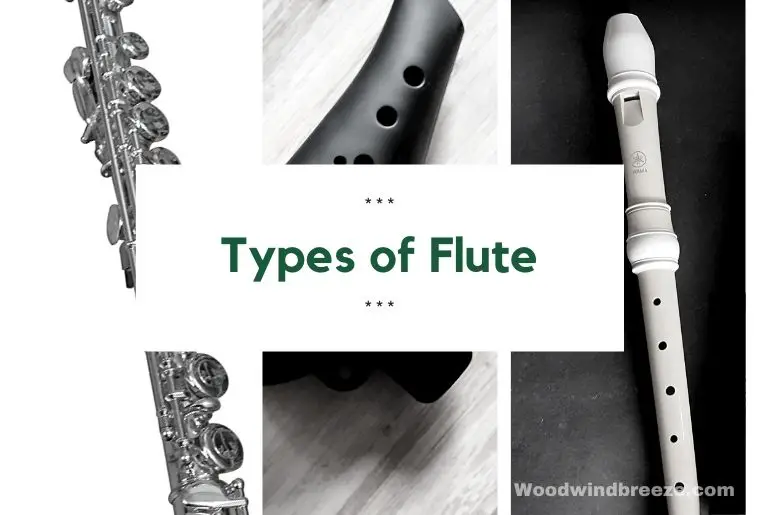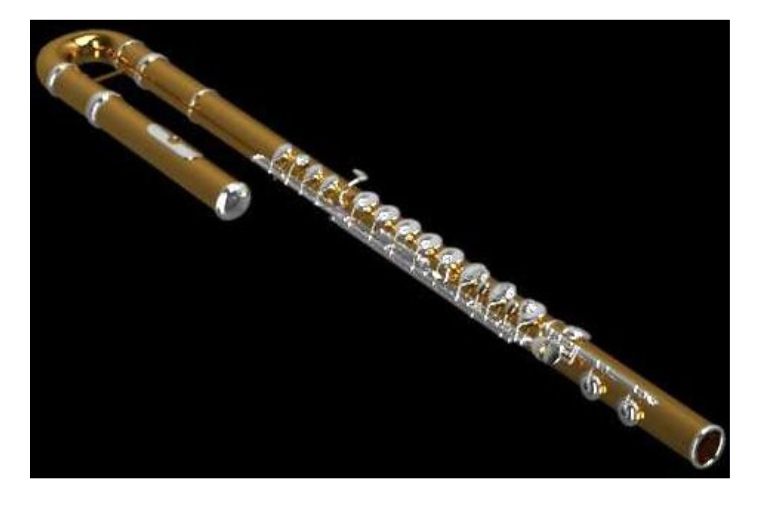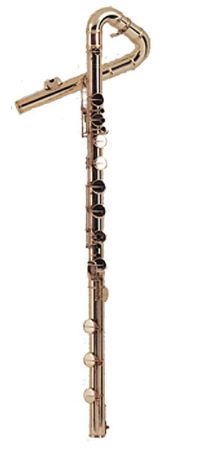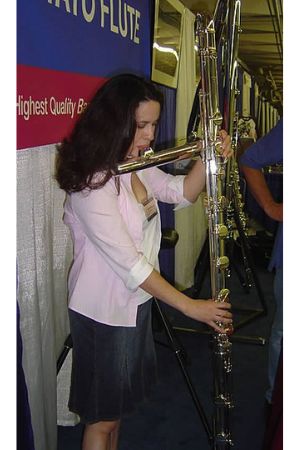The 22 different types of Flutes below include all the standard flutes plus many others. There is such a huge range and they all sound so beautiful yet all very different. Some are great for beginners while others should only be attempted by more experienced players. Everyone will have their favorites.
Goodness! So many flutes, all with their unique style history, and sound. Some you may not have even heard of or realized were classed as flutes. The size and materials of all these instruments vary a lot and show just how each affects the sound. So many to try and no space to put them all!
This list covers many of the popular or unusual flutes that are interesting, but it is by no means all the flutes. As I researched this article I realized like many I had only scratched the surface of the flute world and I discovered more and more flutes.

22 Amazing Types of Flute You Can Have Fun Playing, Their Sounds & Their Background
1. The Piccolo
Type of Flute
The piccolo is tiny. In fact, its name does mean small flute. It is only half the size of your normal flute (concert) and a whole octave higher. Some say it is harder to play as well. Much more difficult to get a sound out of than the concert flute.

The piccolo is a transverse (side playing, horizontally played) flute.
Size of The Piccolo
At only 13 inches/33cm in length the piccolo is only about half the length of the concert flute.
Piccolos Materials
The piccolo is made from many different metals silver-plated nickel or silver.
Sound of the Piccolo
Piccolos are an octave higher than the flute, they are in the key of C these days while originally they were in the key of D♭
Quite an extraordinary piece of music to demonstrate the sound of the piccolo.
Background info
Piccolos are the highest-pitched instrument that is played in orchestras in the woodwind group.
The piccolo uses the same fingering techniques as the larger concert flute. Unlike the flute, traditionally the piccolo had no lip plate and is shaped slightly differently. However, there are lip-plated models on the market now thanks to Powell (source) who created lip plates on the piccolo in 1993.
It’s much easier to transfer from one instrument to the other if both have lip plates.
From Where
The Piccolo comes from western Europe.
2. The Fife
Type
The fife is a cylindrically bored flute that is smaller than the concert flute. It is most often created as one piece but sometimes you will find it in two pieces and has 11 holes.
Sizes
The fife is 15 and a half inches long (about 39cm).
Materials
The fife is made primarily of wood. How lovely. The woods used to make the fife are mostly the following: boxwood, blackwood, rosewood, grenadilla, mopane, pink ivory, cocobolo, maple, or persimmon. (Source)
Sound of the Fife
The fife has about 2 octaves of sound that are both shrill and high pitched and it sounds a bit lispy/airy. It only has 6 holes and is played with 2 hands.
Background Fife Info
The fife has a history that goes back centuries. It is one of the older flutes. It has a firm base in military history having been played as far back as the Crusades as a military instrument (source). It is used for marching and signaling.
The fife has also been used simply for dance music.
The fife has a much narrower bore than other flutes in relation to its overall length.
From Where Does The Fife Come
The fife comes from Europe, some say Portugal but I have been unable to verify the exact location.
3. The Concert Flute
Does the concert flute need an introduction? The most popular of the flutes, it is known worldwide and played by the greats like James Galway.
I get shiny object syndrome every time I look at a flute! lol. I love to take it out of its box and put it together to play. There just has to be some silver in there somewhere! There’s something about this instrument I’ve always found special.
Type of Instrument
The concert flute is a Transverse flute (held horizontally when played) in the key of C, known by several names including the C flute, silver flute, and the Boehm flute, the C Flute, as it’s so well known it’s simply called the flute.
It is an aerophone instrument so it has a vibrating body of air to create the sound. It is also reedless.

Sizes
It is 26 inches (67 cm) long
Materials
The materials vary depending on the cost and quality of the flute. The body and the head joint do not always have the same materials. The most popular flute material is sterling silver. Although it is also made in other types of silver and parts of the flute can also be copper, etc. You can have solid silver or silver-plated nickel flutes. James Galway has (a) gold one (he has several flutes).
Nowadays you can also get beginner plastic flutes.
Each part of the flute can be manufactured with different materials which made the flute quality better or more suitable for a student.
Sound
Background For The Concert Flute
Flutes go back to the paleolithic period or old stone age. the design we see today though only goes back a couple of hundred years and was developed by Theobald Boehm around 1846-1847 (Source)
From Where
The first flutes came from Europe in what is now Germany as did the modern inventor of the flute Theoalkd Boehm.
4. The Alto Flute
Type of Flute
The also is a western flute and part of the concert family. The altos pitch is in the key of G. Altos can have either a straight or curved head. If you are shorter or have difficulty with stretch it’s best to go for the curved head joint as it brings the flute closer to you. If you are taller with a long stretch you can play with the straight head joint. Chose which is easier and more comfortable for you.

Photo The original uploader was Rukario639 at English Wikipedia. License public domain
The Size of the Alto Flute
The alto flute is approximately 34 inches/86cm. It is also thicker around the tube (bore size) than the concert flute.
The Flute Materials For Alto Concert Flutes
The materials that an alto flute is made from can be nickel, silver-plated brass, or silver. Head joins can also be made of gold brass.
Sound
The alto flute is in the key of G and has a lower more mellow sound than your standard concert flute. Listen to it here on YouTube.
Background info
The alto flute is the 3rd most popular flute (of the concert family) and comes in just behind the piccolo and the ever-popular concert flute. Although popularity does sometimes shift with time and fashions.
From Where
The history of the alto flute goes back to the mid-18th century when people started to experiment with flute sizes and worked on changing the bore (tube hole) size. Early designs of the alto flute were flawed. (Source)
5. Bass Flute
Type of Bass Flutes
Thre are different types of base flute these are the standard closed-hole bass, the open hole bass flute, and the Kingma System bass flute.
You can also get the contra subcontrabass flute, double contra base, and the contra-alto flute which are bigger and lower again (described below).
Bass flutes are aerophone wind instruments. Some are played transversely while others are played upright.

The license of the photo (CC by 2.0)
Size of the Bass Flute
The size of the bass flute varies slightly but is around 50-60 inches long (127cm-152.4 cm). There are larger bass flutes ie the contrabass and sub contrabass flutes.
Materials Used in the Bass Flute
Materials vary as with all flutes it depends on how much you want to pay, however, the materials are similar to that of the concert flute.
The bodies of bass flutes are typically silver-plated however some are gold-brass alloy bodies with silver-plated nickel-silver mechanisms.
Often the head joints are made of better material than the bodies. For example, Yamaha has a bass flute with a gold brass alloy held joint with a Sterling silver lip plate and riser.
Sound of the Bass Flute
The bass is a lower sound than the concert flute and is an octave below it. It is in the Key of C
6. The Contra Alto Flute
The contra-alto flute goes between the base and the contrabass flute in pitch. It goes by different names such as the contrabass flute in G or bass flute in F (source)

Photo Credit: TheCuriousGirl110 Licence
Creative Commons Share Alike 4.0
7. Contra Bass
It is two octaves below the concert flute (source). This is a very large flute ad because of this the neck has to be bent and it is supported by the floor.

Photo American flutist Maria Ramey playing a Kotato en: contrabass flute.
The photo was taken at a flute convention.
Creative Commons license CC by 3.0
8. Subcontrabass Flute
Type ie end-blown side
The sub-contrabass flute begins at 1/2 an octave below the contra base and it is tuned in G (source). It is also a whole 2.5 octaves below the concert flute that most people like myself play.
9. The Double Contrabass Flute
Materials
Because they are so expensive most people actually use plastic pipes rather than the real deal.
Sound
As you’d expect from such a large instrument they are very low in sound. It’s lowest C and is one octave below the contra base and 3 octaves below the concert flute.
Background info
There are only 4 of these super huge instruments in the world.
From Where
They are made in Tokyo.
10. The Ocarina
Until a year ago I’d never even heard of this beautiful and amazing instrument. Now it is a favorite to play. The ocarina is a vessel flute also called a globular flute. Typically ocarinas have a fipple or whistle opening to play them.
Type Of Flute

Ocarinas are unusual in that they come in many shapes. The most popular is the transverse sweet potato shape. Even within that shape, there are many variations from fat and dumpy through to thin and elegant. I like the more rounded ones but ocarina players rarely only have one ocarina.
The ocarina is a woodwind instrument.
***
Ocarina Sizes
Ocarinas come in many sizes. You can get single, double, and even triple ocarinas. They can be single or double chambers. You get the small 4 to 6-holed ocarinas which are usually pendents, tenors, altos, and bass. These are starter instruments meant mostly for children. You can get single, double, and even triple ocarinas. These range from beginners through to pro instruments. Although adult beginners usually use single ocarinas like the one pictured above as they have fewer holes.
If you are looking to get an ocarina be aware that the altos are also called tenors by some brands just to confuse the issue.
Materials The Ocarina Is Made From
Ocarinas are traditionally made from clay or ceramic but are also made from wood and plastic. You may also find some bones, glass, or even metal ones on occasion.
Ocarinas have different amounts of holes. You can get 4, 6, 12,18 holed ocarinas.
The Ocarina Sound
The sound varies but the ocarina has a hauntingly beautiful sound. Even the higher-pitched ocarinas don’t hurt your ears the way some recorders do. Even though they generally don’t have as large a range of notes as a normal flute they still have some fantastic music. In fact, your standard 12-hole only has 1.25 of an octave. If you want to get a bigger range of notes you have to get an ocarina with more holes.
An example of the ocarina being played by one of my favorite ocarina players on Youtube.
Background Ocarina Info
Ocarinas have been made popular by the video game The Legend of Zelda. But they actually date back 12 thousand years. The more modern version was created by Giuseppe Donati in 1853.
Where Does The Ocarina Come From
According to Wikipedia (Source), ocarinas are 12,000 years old and come from different parts of the world with the oldest one having been found in Runik, Kosovo. They have also been found in China and South America.
11. The Recorder – soprano, alto, tenor, bass
Love them or hate them the recorder instrument is one of the most popular flutes that you can play and is played worldwide. A recorder is an internal duct flute or fipple flute.
Types of Recorder Instrument
The recorder is an internal duct instrument. You blow at the end.

Recorder Instrument Sizes
Recorders come in many different sizes the most popular sizes include the sopranino, soprano, alto, tenor, and bass. You can find more information on the sizes of recorders and their sounds here.
Recorder Materials
The modern recorder is usually made from plastic or wood. Traditionally they would have been made from ivory or wood.
Recorder Sounds
Most people are familiar with the screechy sound of the cheap soprano. I cringe at the sound of the recorder which isn’t really fair as they can sound lovely. I have an alto and it’s lower and takes away that it’s killing my ears feel.
Plastic recorders of the same quality have fairly standard sounds however wooden recorders the sound even at the same size recorder can vary a lot.
There are also baroque and modern pitched recorders. The modern pitch has a slightly higher sound than the baroque.
Do we really want to hear the recorder sound? Yes, because it doesn’t always sound like you think! Below is an example I found on YouTube o of a tenor recorder being played. It’s quite beautiful.
Background info
The recorder in its current form came about around the 15th century (source), however, it has been about for much longer than that. Its popularity has phased in and out over the years. Not it’s a popular instrument worldwide.
From Where
The first records of any recorder instruments are from the middle ages in Europe.
12. Double or Drone Flute
The double flute is an unusual flute that has as the name implies double chambers. These chambers can be in a v shape or joined together. You can also get them stacked. On one side you can play the notes much like you would any other front-held flute while on the other side there is one note or drone note and the chamber doesn’t have any hols for fingers.
You can play these either separately or together. Played together the should flute makes for an interesting sound.
Some double flutes are as easy to play as a single flute. you just need to add more breath.

license photo: CC by SA 2.0 from Wikipedia (Claire H. from New York City, USA – Double Flutes)
Type of Flute
Double or drone flutes are front-held flutes.
Sizes
The length of these flutes varies however they are around 16-22 inches long (41 – 56cm).
Double Flute Materials
Double/drone flutes are made from either bamboo or wood like cedar or walnut. You can also get them in plastic.
Sound
The double flute has a very unique sound. it seems to be both clear and whispy at the same time. It has a warm mellow sound
Background info
Drone flutes are over 3 thousand years old! They have been found in El Salvador from the pre-classic period 1250 BC to 550AD (source).
From Where
While originally they are most likely to have been native America these days they are made the world over. We have a maker of these just one county up. And they also teach how to make them.
13. The Triple Flute
Type
A triple flute is simply 3 flutes joined to make one flute. However, each of the three flutes is slightly different. the center flute has holes in it. One side is a drone flute with no holes to play. The other side has 3 holes. (Source: Video below). However, the hole quantities may vary.
How Does The Tripple Flute Sound?
It sounds hauntingly beautiful. Below is an example of the triple flute being played.
Background info
From Where
The triple flute is a native American flute with 3 chambers one of which has a drone chamber. The two parts are played while the drone harmonised the sound.
14. The Japanese Shakuhachi Flute
Type: The Shakuhachi Flute
The shakuhachi flute is a traditional Japanese bamboo flute that is still very popular today. You can get them all over the world
Materials
This flute is made from thick-walled Bamboo.
It’s Size
The name comes from its original size as one shaku (11.93 inches (30.3 cm)) and 8 (Japanese: hachi) sun (1.2 inches (3 cm)) (source). However, nowadays these flutes come in lots of different sizes, which is just as well as the holes that look quite big.
How Does It Sound
It sounds kind of mellow and whispy. The flute is played vertically and the sound is created by manipulation of airflow by the mouth and muscle control (source).
From Where
From Japan now however it originally came from originally derived from the Chinese xiao in the 8th century. (source)
15. The Shinobue A Transverse Japanese Flute
Type
The shinobue flute is a high-pitched transverse Japanese flute with a much higher pitch sound than the previous flute. It has a clearer sound as well you can hear it on Youtube
It usually has only 6 or 7 holes for fingers.
materials
The flute is usually made from shinodake (small bamboo) (Source). This is usually lacquered/coated to stop the bamboo from cracking.
It is classed as a reed instrument.
Sound
From Where
The flute is believed to have come from China originally as the slightly larger ryuteki flute and been developed from there.
16. The Sodina Flute
Type
This is an end-blown flute
Sizes
This flute varies in size. And the size depends on which region it is being used in.
Materials
The sodina flute is usually made from bamboo, lightwood, or reed and also plastic.

CC by 3.0 credit to Sodina, a traditional flute played in Madagascar. Lemurbaby (talk) 19:32, 21 November 2010 (UTC)
From Where
This flute comes from Madagascar.
17. The Chinese Dizi Flute
Type
The traditional Chinese flute is a transverse (side played) flute called the dizi or sometimes a simple bamboo flute. Interestingly the hole for blowing is much further down the flute than the western flutes.
Sizes of the Dizi Flute
The dizi flute ranges in size and is typically about 75 to 85 cm (29.5-33.5 inches) in length but can be as little as 45cm (Just under 18 inches) and as large as 1.25m (approx, 49 inches).
What Materials Is the Dizi Flute Made From?
The dizi is usually made from bamboo. However, it has also been made from marble or even jade.
Sound
Quite a clear flute sound. Higher pitched quite beautiful. Although like western flutes the dizi comes in different sizes and sounds.
They have a range of about an octave which seems to be the range of most older traditional flutes. Listen Here on Youtube
Background Info
The dizi or bamboo flute is very popular in China for its traditional music.
Chinese flutes have been found to be in China for at least 7 to 9,000 years!
18. The Native American Flute
The Native American flute has several different names, these include the love flute or the courting flute. It is made differently from the western style flutes. It has two chambers instead of one. This means you do not need to have embouchure, unlike the western flutes. (Source)
Type of Flute
It is an end-blown flute. It is an aerophone flute (a flute that causes a body of air to vibrate without a membrane or strings (source)
Sizes of This Flute
The Native American flute comes in lots of different sizes and different styles.
Materials Used For the Native American Flute
The Native American flute always has come in a very wide range of materials. Traditionally they were made from wood, bamboo, river cane, and even saw grass.
Today those materials have expanded to include plastic, ceramic, and even glass. Wood is still used. With the challenges of protecting woods, the traditional woods are being swapped in some cases for more sustainable woods.
Popular woods for these flutes include redwood, cedar, and cherry.
It’s Sound
Like the ocarina, it has a limited range of between 1 and 1 1/3 octaves. Its sound is clear and mellow. You can hear them on YouTube
Background info
According to atflutes.com, there is no clear-cut answer to the history and exact location, and timeline of these flutes due to the native Americans not having a written language and being nomadic. Many tribes would have used these flutes. Originally this flute would have been played only by the men of the tribe. (Source).
19. Pan Pipes
Type
This is an end-blown flute as the person blows into the ends of each pipe.
Materials For Pan Flutes
Usually, the materials used for pan pipes are from local reeds or bamboo, or even giant cane. However, they are also made from other materials such as materials including plastic, wood, metal, and ivory.
How Do They Sound
I love this piece by the Animals. I’ve been playing it on my uke. However, here we have it on pan pipes.
Background Info
Pop on this page for For more fun panpipe facts.
From Where
20. Korean Flute
The Korean flute is of particular interest because it has a membrane that buzzes, This gives it a really distinctive sound compared to the other types of flute.
Materials
This flute is usually made from bamboo
Sound
You can hear this flute in this video on Youtube
Background info
This flute is called the daegeum it is a side-blown flute. It is the biggest of the three flutes from the Unified Shilla Dynasty (618-932) according to TalkTalk Korea (source)
From Where
It comes from Korea
21. The Suling Flute
The Suling comes from South East Asia. Tamiang.

Creative Commons CC by SA 4.0 by Nahata def fathan
Type
The Suling is an end-blown flute. There are different types of suling flute like the Mridangam & Palendag & tumpong.
(Source)
Sizes
The sizes of the suling flute vary.
Materials
The suling flute is typically made from thin bamboo.
Sound of the Suling Flute
The sound varies depending on the size of the flute.
I love the way the sound is enhanced by the movement of the fingers. You can hear an example here
Background Information on the Flute
It is a popular flute throughout Indonesia for gamelan orchestras (gamelan is an orchestra with instruments from Bali and Java and Indonesia)
Where Does It Come From?
The suling flute comes from Indonesia and is from the Sundanese people. It can also be found in Southeast Asian countries, especially in the Philippines, Brunei, Malaysia, Indonesia, and Singapore. (source)
22. Washint
The Washint is an end-blown flute made from wood. It originally came from Ethiopia.